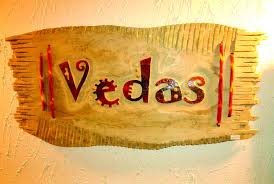 Veda means “knowledge,” but specifically refers to the eternal wisdom of the four collections of hymns, sacrificial rituals, andVayu, the wind, shown riding his vahana, the antelope other sacred texts that are called the Vedas. Along with the four
Veda means “knowledge,” but specifically refers to the eternal wisdom of the four collections of hymns, sacrificial rituals, andVayu, the wind, shown riding his vahana, the antelope other sacred texts that are called the Vedas. Along with the four
collections (the Samhitas, the Brahmanas, the Aranyakas, and the Upanishads), two more bodies of literature, the Sutras and the Vedangas, are sometimes included in the Vedas. The Vedas are said not to be composed by human hand (apaurusheya). Tradition teaches that they have always existed, and myth accounts for the preservation and reappearance of the Vedas after each dissolution of the universe. The seven seers (sapta-rishis) in most accounts, the Manu of the age (who might also be a maharishi), or an avatara (incarnation) like the boar (Vamana) incarnation of Vishnu makes sure that the inerrant Vedas come into an age. But the myths show an anxiety about how they are preserved as an evil time sets in, or when demons have stolen the Vedas and an avatara is required to restore them.
Even so, many believe that the Vedas contain all knowledge (veda) past and future. All science has been discovered in some previous age, and there is evidence of the gods or demons using airplanes to cross the sky, as does Ravana
when he captures Sita, and using missiles and nuclear weapons against each other, as does Indra when he launches his vajra (divine weapon, formerly a lightning bolt) or Rama his “arrows.”
The Aryans resisted all forms of writing for several millennia even after they had come in contact with it, depending instead on their educational system and memory techniques (pathas, vikritis). An oral scriptural tradition and its reverent transmission was believed to be more reliable than writing, because writing could be altered, while a collective memory could not. The Vedas were therefore known as sruti, “that which is heard.” There were several schools (sakhas) and subschools (caranas) that kept alive variations within the tradition.
Scholars have argued that internal examination of the Vedic corpus indicates a time when the Aryans knew of but had not yet migrated to what is now northeastern Pakistan and northwestern India. They called this region Sap- tasindhu (the seven rivers’ land). They shared an ancestry with their pre-Avestan cousins who later inhabited what is now Iran. The early part of the Vedic or Samhita period (c. 1500-900 b.c.e.) appears to have been a time when the warriors (kshatriyas) were highest in esteem and power and the priests (brahmins) were charismatic prayers and ritualists. The later Vedic period was a time of religious transformation, with several triads of gods rising to and then losing supremacy (the last triad of the period being Agni, Indra, and Surya), Varuna’s rapid decline, the loss of the entheogen (“god-experience”-inducing plant) soma from actual ritual use sometime before the end of the Brahmana and Aranyaka period (c. 900-c. 600 b.c.e.), and the rise of the godling (aditya) Vishnu and a non- Aryan god of the cremation ground, Siva, to supremacy over the Vedic pantheon. (There are major entries on each of the aspects of Vedic religion.)
Within the Samhitas (collections) is a fourth section known as the Atharvaveda that is quite unlike the rest in tone and content. The other three sections were often referred to as the three (triyi) Vedas, excluding or assigning lesser authority to the Atharvaveda. It was filled with magic, both positive and negative, ranging from mantras and potions for fertility to death prayers. In fact the notion of knowing brahman, in the sense of power, was what the Atharva priests claimed, as over against the rituals and sacrifices of Vedic brahmins. They knew the power (brahman) and the magic (maya) that could control both gods and sacrifice. Although their practice does not come unaltered into later periods, their influence on Hindu mythology and its practices to acquire magic powers (siddhis) has not been fully accounted for. Their magical practices were called the panca (five) kalpas (sacred precepts).
The period when the Brahmana and Aranyaka literature were created closed with a priesthood that was asserting its primacy over the other castes (varnas), confident that its “science” of sacrificial rituals and Vedic chanting (mantrayana) could control the universe and optimistic that it knew how to prepare Aryans for a life beyond the grave.
The Upanishadic literature was not included as part of the Vedic corpus for centuries after its composition. Its outlook challenged the hereditary nature of the Brahmanical priesthood, its sacrificial religion, its knowledge of that One by which everything was known (Brahman), and its notion of the afterlife. Once this challenge was integrated into a new worldview, the fourfold Vedas would become authoritative, orthodox, and orthopraxic for what would eventually become Hinduism. But many would maintain that Vedic authority was a symbol and Hindu mythology of the Puranas was the reality.
